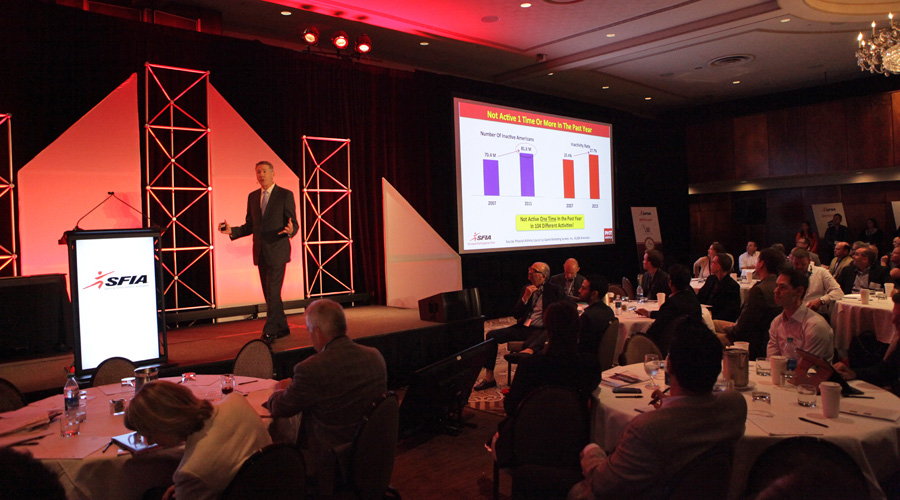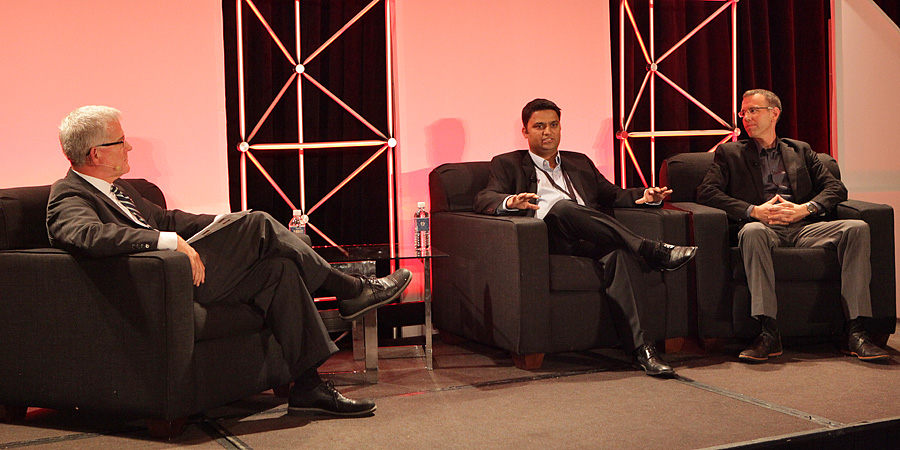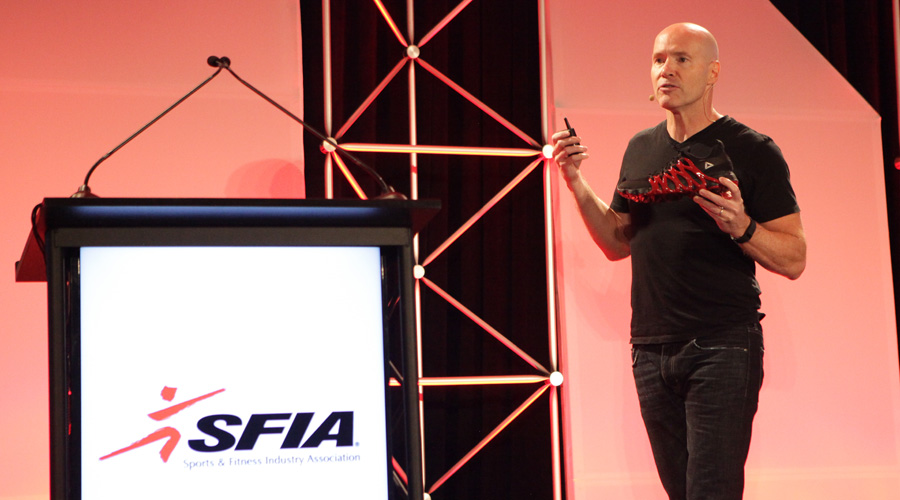By David Clucas
There is plenty of disruption in the sports and fitness industry — retail bankruptcies, rapid technology and fashion-trend shifts and a transition to millennials as primary purchasers, to name a few.
But if the 2016 Sports and Fitness Industry Leaders Summit in Denver, September 14-15, was any indication of how the industry’s brands and playmakers will navigate that disruption, there’s a chance for calmer waters ahead.
That’s not to say things won’t be choppy in the short term.
In fact, rapid change needs to happen, said SFIA Chairman and Life Fitness President Chris Clawson, pointing to the association’s most recent figures that show the number of inactive Americans — those that didn’t even go for one jog or hike in 2015 — grew to 81.6 million, up 16 percent from 2007. In addition, 10 percent fewer Americans reported being active at least three times a week in the past five years.

Life Fitness President and SFIA Chairman Chris Clawson addresses the audience at the 2016 SIFA Industry Leaders Conference.
“That figure should scare everyone in this room,” Clawson said, as that segment represents the heart of the industry’s customer base. Another trend to note: casual participation of sports — e.g. a pick-up game of basketball versus league play — rose, while core participation declined.
“Going forward, the key to our business is youth,” he said. “We have to activate and invest in children. If we can get them activated, they will find a way into our industry.” In other words, the upfront investment in youth sports and activities will pay off in the long run.
Participation in 10 of 12 youth sports has declined in the past five years, with gains only seen in softball and lacrosse, Clawson said.
The good news for the industry, said SFIA President and CEO Tom Cove, is that despite all the challenges, particularly in retail — including that day’s news that Golfsmith had added itself to the growing list of sporting goods retailers to file for bankruptcy — overall sales in the industry are still up, reflecting strong consumer demand for sports and fitness products. Still, he noted, it was no time for industry leaders to rest, given the challenges ahead.
Innovating Process
One of those challenges is the never-ending drive for innovation, said Reebok’s Vice President and Head of Future Bill McInnis (pictured above). But instead of just new products, the industry has to think about new processes, especially on the manufacturing front.
“We’ve hop-scotched around the globe chasing inexpensive labor and we’re running out of places to go,” he said. He pointed to footwear as an example, where, he said, brands have been making shoes pretty much the same way for 25 years, using molds for soles, which are expensive, time-consuming, not environmentally friendly and not customizable once the metal is cast.
“We keep hearing about 3-D printing. ‘It’s coming, it’s coming, it’s coming …’ but it’s still not here. It’s great for prototyping, but not for mass production. It’s coming, but not next week, not next month, not next year.”
So Reebok turned to the auto industry to get some better ideas on automation, he said. The discovery was robots that can precisely draw with liquid polyurethanes, which later harden to create the shoe’s rubber, versus molding it. “Where you draw, it sticks,” McInnis said. The big advantages of the technology are that designers can set the machines to create whatever they dream up, including using different densities of rubber for traction and flexibility, without any wasted material. And officials believe that once perfected, the process will cut product lead times in half. Finally, what Reebok is dubbing its “liquid factories” will be able to be located anywhere in the world, including the United States. It doesn’t take as many people to run the machines, therefore evening out labor costs.
Reebok will officially debut the manufacturing technology in late September with a limited-run shoe — 300 pairs — designed and assembled in the United States.
“It’s not a new shoe,” McInnis said. “It’s a new process.”
While the technology primarily focuses on a shoe’s sole and rubber parts, McInnis said, a shoe’s upper isn’t far off from similar advances, perhaps referring to Reebok’s sister brand Adidas and some competitors, which have invested in automated knitting machines to construct uppers.
Skilled Labor Needs
While technology and smarter machines might help bring back some jobs to the United States, it won’t replace the millions lost when factories went overseas. The solution will be better training, said U.S. Secretary of Labor Thomas Perez, who was the event’s highest-profile speaker.
“I always ask businesses, ‘What can we do to help?’” he said. “They always answer, ‘We need more skilled workers and new customers.’”
While the government can help, it’s also up to businesses to do their part, Perez said. “We’ve seen companies committed to investing in tech, but we must also make investments in our people.”
He continued: “Your current HR strategy is cannibalism — stealing your competitor’s talent and they turn around and steal your talent. We have a tremendous opportunity to create a skilled labor force with the next generation — when I have a problem with my iPhone, I don’t call Apple, I turn to my 14-year-old — these kids are smart. We have to invest in training and apprenticeships.”
Perez added that companies who want the best skilled labor will also have to focus on company culture and sustainability.
“If you want millennials, you need 21st century HR,” he said. “These are conscious consumers and employees — they’re looking at the sustainability of your supply chain and voting with their feet.”
Finally, on pay, Perez alluded to the Obama’s administration’s upcoming labor rule on overtime, which among other things will stipulate that a salaried worker must make at least $47,500 a year to be exempt from being paid time-and-a-half for overtime.
“It’s Henry Ford economics,” Perez said. “He doubled wages at one point, because, first, he wanted to reduce attrition, and second, he wanted his workers to be able to at least afford the products they were making.”
Perez also urged businesses to support “sensible federal family-leave policies and child-care support.”
“If we would have kept pace with Canada on this front, we’d have 5 million more women in the workplace,” he said.
Political And Economic Forecast
Politics and its effect on the economy remained front and center at the SFIA Industry Leaders Summit with a presentation from Bernard Baumohl, chief global economist for the Economic Outlook Group.
Baumohl contended that politics play a much larger role in economic forecasting than many economists give it credit for. “One cannot be just an economist; one must be a political economist,” he said. “Don’t believe any forecast that doesn’t also say who is going to be in the White House.”
Given that, Baumohl said his group believes Hillary Clinton will win the election and that GDP will grow between 2 and 3 percent through 2018. Interest rates will begin creeping up, but not until after the election, he said. Oil prices should gradually rebalance between $50 and $60 a barrel. “The challenge for OPEC is to not let the price go too high that it re-ignites the U.S. fracking industry,” he said.
While that’s all good news for the economy, there are risks that can derail any forecast, Baumohl said. Terrorism in Europe, particularly on so-called soft targets, could really hamper the tourism economy there. And Baumohl said there’s increasing evidence that terror and militant groups will begin trying to de-stabilize Saudi Arabia, which could greatly affect oil supplies. Increases in cyber threats and consumer data hacking are rising problems for businesses and governments, and so is shipping and supply chain threats, including China’s activity in the South China Sea.
Quizzing Amazon
Coming back to the topic of selling sporting and fitness goods, one of the more anticipated events at the SFIA Industry Leaders Summit was a conversation with the Amazon.com Sports segment leadership, moderated by SFIA’s Cove.
“At the core, Amazon is customer obsessed,” said Fouzan Mansuri, director and Sports category leader for the online retail giant. “Every time we look a problem, we look at how it affects the consumer.” He added that the company focuses on “invention…a willingness to fail…and patience to think long term.”
Specifically within the sports category, Mansuri said the retailer has seen its best success within its Amazon Family and Amazon Student segments. The Amazon Sports customer tends to trend younger and has a higher income, he added. But, he clarified, “we really do see each customer as his or her own customer segment…the algorithms are based on their unique buying patterns.”

SFIA CEO and President Tom Cove (left) moderates a conversation with Amazon.com Sports’ Category Leader Fouzan Mansuri (center) and Senior Manager Ryan Elvers (right).
The challenge facing Amazon isn’t data, said Ryan Elvers, Amazon’s senior manager of sports marketing and marketplace. “We have more than enough data. The challenge is how to inspire. Most customers know what they want when they come to Amazon, but what about those who want to browse?”
On that front, Amazon is having success with creating “new-and-interesting-find lists” for consumers, and largely through mobile-device endless scrolling, it has found that shoppers will spend time browsing.
So how do sports brands make sure their products get to the top of such lists and other search results on Amazon?
“The algorithm is a constantly changing flywheel,” Elvers said, so there’s no single answer. “It comes down to how many people reached your product, and of those people, how many bought your product.” Reviews also help, he said.
Best tips for brands wanting to sell their products on Amazon? “Think about your online strategy and how it fits into your overall strategy,” Mansuri said. “Think about how that product works online, too. How it’s shown online — photos, videos, colors — and how the packaging will fare in transport.”
Photos by David Clucas


















